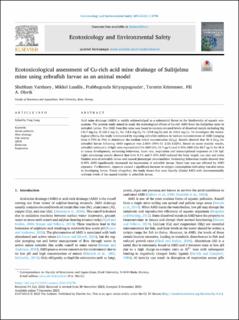Ecotoxicological assessment of Cu-rich acid mine drainage of Sulitjelma mine using zebrafish larvae as an animal model
Varshney, Shubham; Lundås, Mikkel; Siriyappagouder, Prabhugouda; Kristensen, Torstein; Olsvik, Pål Asgeir
Others
Accepted version
Permanent lenke
https://hdl.handle.net/11250/3109799Utgivelsesdato
2024Metadata
Vis full innførselSamlinger
- Articles [3012]
- Publikasjoner fra CRIStin [3070]
Originalversjon
10.1016/j.ecoenv.2023.115796Sammendrag
Acid mine drainage (AMD) is widely acknowledged as a substantial threat to the biodiversity of aquatic ecosystems. The present study aimed to study the toxicological effects of Cu-rich AMD from the Sulitjelma mine in zebrafish larvae. The AMD from this mine was found to contain elevated levels of dissolved metals including Mg (46.7 mg/L), Al (20.2 mg/L), Cu (18.3 mg/L), Fe (19.8 mg/L) and Zn (10.6 mg/L). To investigate the toxicological effects, the study commenced by exposing zebrafish embryos to various concentrations of AMD (ranging from 0.75% to 9%) to determine the median lethal concentration (LC50). Results showed that 96 h LC50 for zebrafish larvae following AMD exposure was 2.86% (95% CI: 2.32–3.52%). Based on acute toxicity results, zebrafish embryos (<2 hpf) were exposed to 0.1% AMD (Cu: 21.7 µg/L) and 0.45% AMD (Cu: 85.7 µg/L) for 96 h to assess development, swimming behaviour, heart rate, respiration and transcriptional responses at 116 hpf. Light microscopy results showed that both 0.1% and 0.45% AMD reduced the body length, eye size and swim bladder area of zebrafish larvae and caused phenotypic abnormalities. Swimming behaviour results showed that 0.45% AMD significantly decreased the locomotion of zebrafish larvae. Heart rate was not affected by AMD exposure. Furthermore, exposure caused a significant increase in oxygen consumption indicating vascular stress in developing larvae. Taken altogether, the study shows that even heavily diluted AMD with environmentally relevant levels of Cu caused toxicity in zebrafish larvae.
